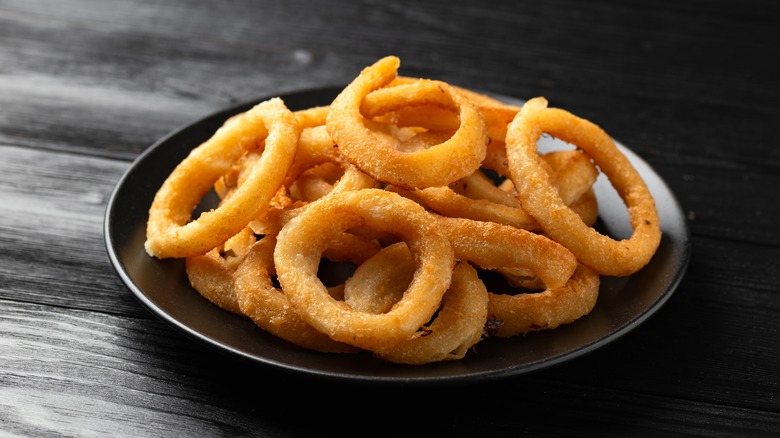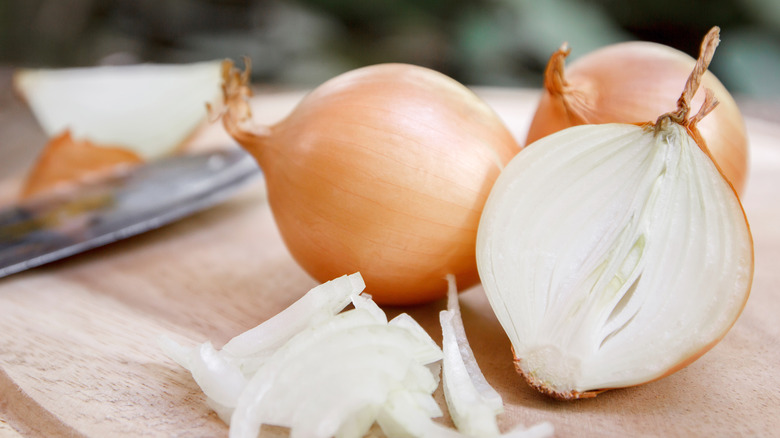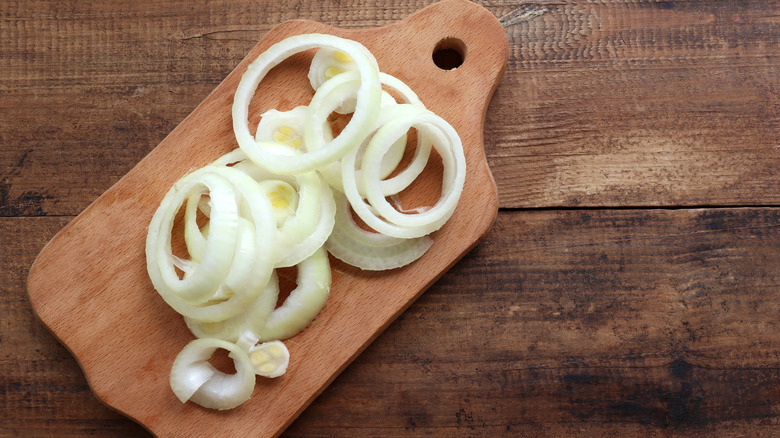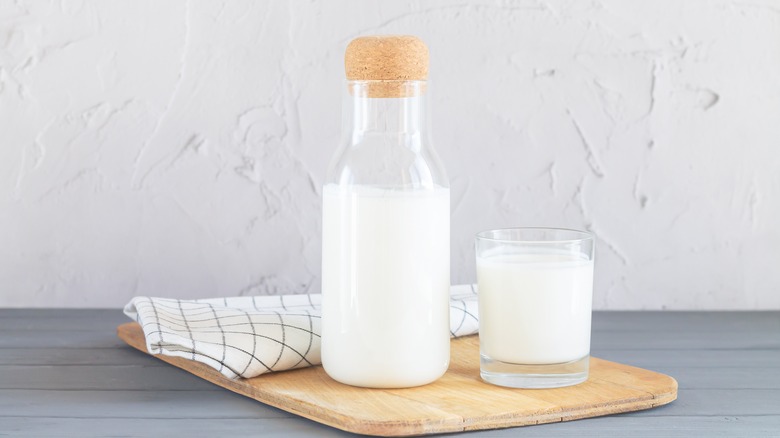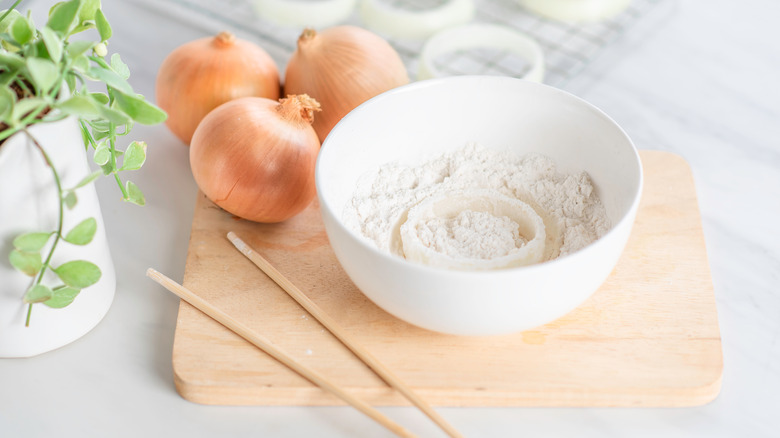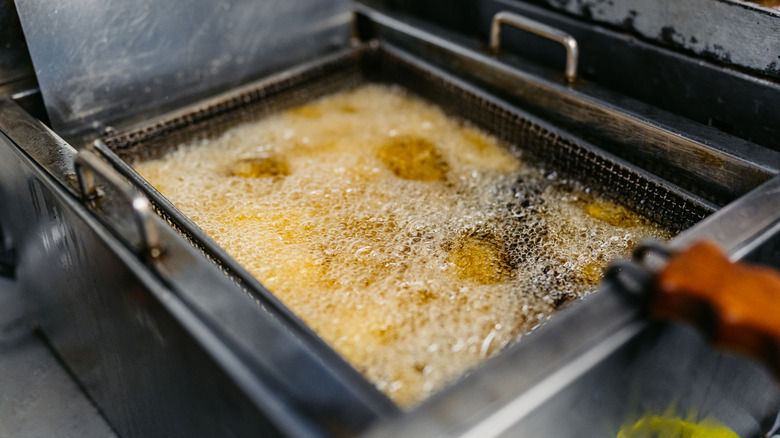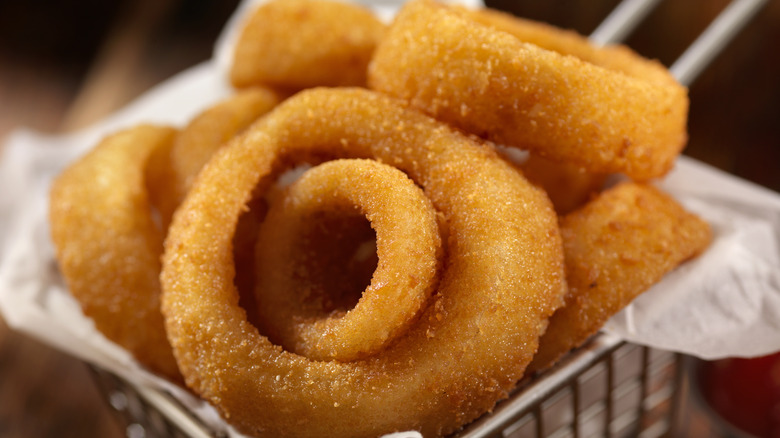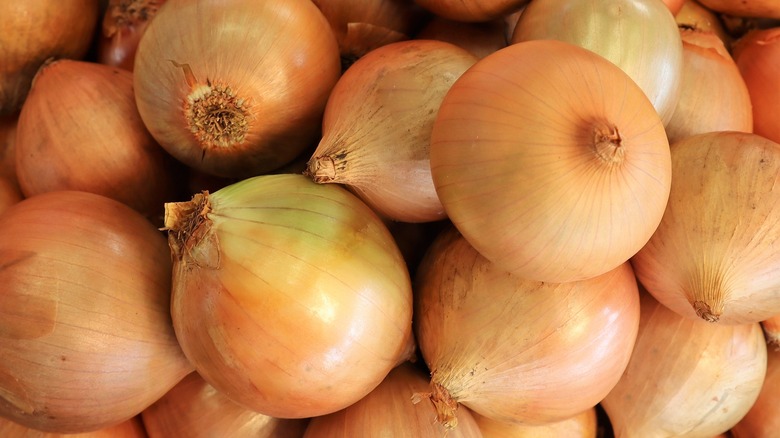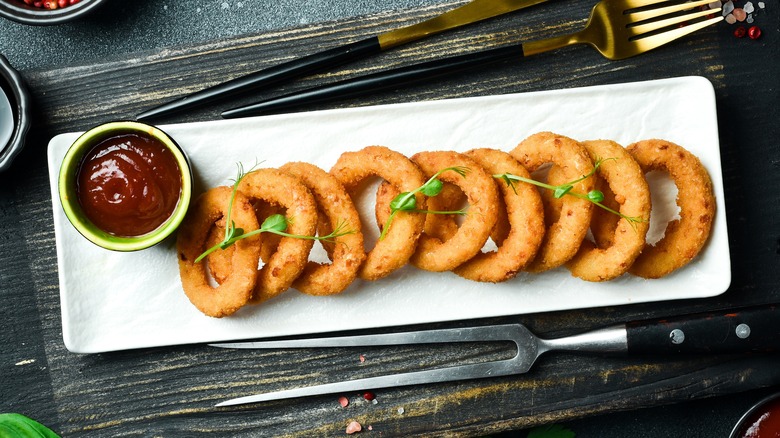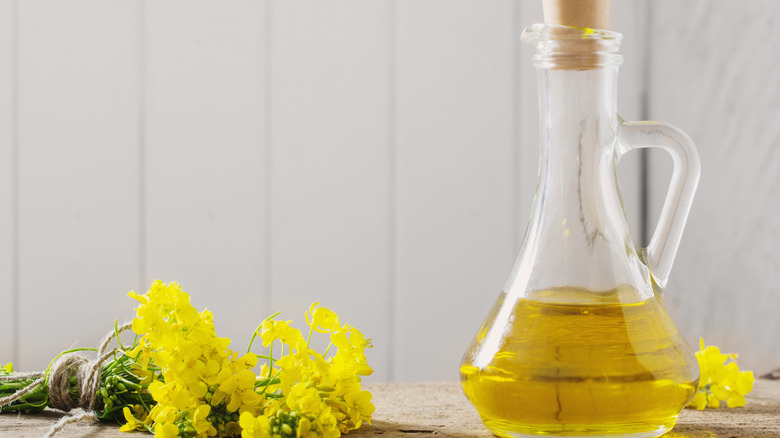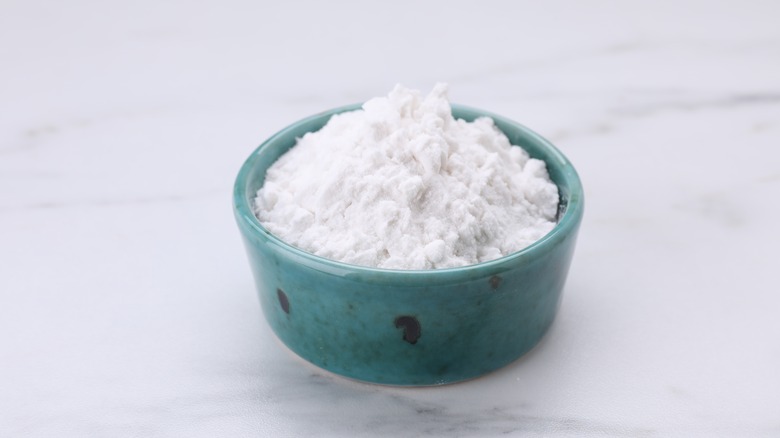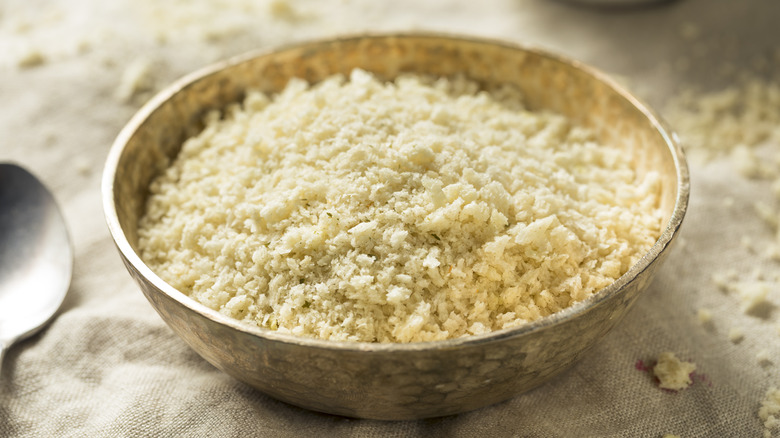Why Onion Rings Always Taste Better At A Restaurant
In our opinion, onion rings are the ultimate side. Keep your fries and your tater tots, folks — when we're in a restaurant, we're ordering these crispy, moist morsels of delicate, juicy onion and crunchy, salty batter. We're not the only ones, either. People seriously love onion rings, and consumers have a lot to say about them. Research led by Brisan Group notes that crispiness, smoothness of the onion ring's batter, and flavor innovation are at the top of the list of what folks love.
All of these factors are difficult to achieve at home, but seem effortless in a restaurant. Restaurant chefs have nailed making onion rings, apparently achieving the perfect balance of batter, onion, and seasoning every time. These chefs have also discovered a few key secrets over the years that have largely been kept to restaurant kitchens. Essentially, they treat their onions and coatings very differently than people making onion rings at home do. Well, why should they have all the fun? We decided to break into these kitchens (not literally, of course), and figure out exactly what these restaurant chefs have been hiding from us. Behold, the secrets of restaurant onion rings.
It all starts with the biggest onions possible
If you've ever cooked onion rings at home before, you'll know how disappointing they can be to look at once they're finished. This is usually because, instead of the jumbo-sized rings you get in restaurants, you usually end up with a collection of small hoops that deliver one or two bites maximum. Restaurant chefs avoid this by using the biggest onions possible when they make their rings. They source extra-large yellow onions from wholesalers, which gives them a generous collection of big, juicy rings to work with, then peel and slice them by hand.
If you don't have access to a wholesaler, finding such onions can be tricky, as the ones in supermarkets tend to be way smaller. Certain online retailers, though, sell jumbo onions, and while you may have to pay slightly more for these massive alliums, your onion rings will thank you. Although these onions tend to come in bumper bags, onions will last for up to three months when stored in a dark, dry, cool pantry or drawer, so you can save the rest for more onion rings further down the line.
Their rings are sliced to perfection
When it comes to onion rings, it's all about how you slice them — and restaurant chefs have nailed the technique. The most important thing is to not go too thin with your onion rings. When slicing, make sure the rings are thick and chunky, with every slice being the same thickness as the last. Restaurants also make sure that each slice is cut evenly, not getting thinner or thicker as the knife runs through the onion.
To nail your slice, begin by peeling your onion, then slicing the end off. Don't throw this piece away, as you can use it to flavor a stock or a soup. Then, once the exposed onion is wide enough, cut straight down the middle to release a big, beefy slice of onion. Carefully separate the interior rings from each other, popping each one out until the rings you're left with are too small to use (again, you can use these to cook a flavorful broth with, or chop them up and sauté them in your next meal). If any of your rings tear, make sure you throw them away; they're not worth the trouble.
Restaurants soak their rings in buttermilk
Ever wondered how restaurant onion rings get rid of that sharp, acidic, bitter taste ? It's all down to the fact that restaurant onion rings undergo a soaking period. Once they've sliced their onion rings, chefs soak them in a large bowl of buttermilk. They're placed in the fridge for around an hour or so, before being pulled out and coated with flour and batter.
This soaking period performs several functions. The first improves the onions' taste. Buttermilk helps to reduce the sulfur compounds in onions, which is what gives them that harsh, overly-tangy flavor (and subsequent onion breath). Soaked onion rings develop a more mellow, subtle flavor, and a hint of dairy creaminess that adds an entirely new dynamic. Additionally, the buttermilk also helps the flour stick to the onion flesh better, ensuring fuller coverage and giving the batter more to cling onto. This, in turn, creates a thicker, more satisfying batter, a better crunch, and an overall more exciting eating experience.
Some restaurants double-dredge their rings
Dredging your onion rings in flour is an essential step in their preparation. By dredging your onion rings, you dry out the surface of your onion and prevent your onion ring batter from falling off. This helps you avoid any bits of onion sticking out of the batter, and makes sure that every bite you take is crunchy, salty, and fatty.
Most people, when making onion rings at home, only dredge their rings once before they dip them in the batter. In Bobby Flay's restaurant, Bobby's Burger Palace, things are done a little differently. Flay double-dredges his onion rings by first dipping them in flour, then in batter, and then repeating the whole process. By doing this, Flay builds up a thick coating of batter on every ring, and ensures that even the slipperiest onions get adequately covered. It's important to remember that double-dredging is a delicate balance: If you overdo it, you run the risk of creating an onion ring that's all batter and no onion. Make sure you tread lightly when dredging each ring, and avoid creating too thick of a coating.
In restaurants, they pay strict attention to temperature
Because cooking onion rings is relatively simple, you need to make sure that every step is executed to perfection. This is something restaurants value highly — and they pay particular attention to the frying process. In restaurant kitchens, oil temperatures are monitored incredibly carefully, to ensure that onion rings don't cook too quickly and burn, or else undercook.
Generally, restaurants deep-fry their edibles between 350 and 375 degrees Fahrenheit, the ideal temperature range to ensure that foods develop a golden-brown, crispy exterior yet remain soft and moist inside. With onion rings, they tend to get even more specific than that. 350 degrees Fahrenheit, or even slightly lower, seems to be the temperature favored by restaurant chefs. Anything within 15 degrees of 350 should be fine, but go much lower or higher and you could have some trouble on your hands.
It's also important to consider what other factors can affect your oil's temperature. If you place a big batch of onion rings into your fryer in one go, this can drop the temperature considerably. Additionally, make sure your heat source is consistent and not prone to fluctuation — if you're cooking on a gas stove, you'll need to ensure that your flame doesn't sputter or wane.
Dryness is key
How do you make sure that your onion rings are as crispy as can be? They need to be as dry as possible. Whether you're dredging them in flour or dipping them in an egg wash (or simply popping them in your batter without any prior coating), water is your mortal enemy, and leaving any on your onion flesh comes with consequences. It also risks moisture getting into your deep fryer — and you really don't want that to happen. Any stray droplets can potentially cause a flare-up of oil.
Although you can pat your onion rings dry, either after slicing them or after you soak them in buttermilk or water, restaurant chefs tend to prefer an air-drying method. Allowing them to air dry overnight or for a full day allows any excess moisture to completely evaporate, making sure your onion rings are ready to be coated. Don't worry about them turning brittle, either: Onions are pretty good at retaining their interior moisture content, even when sliced. To speed things up, you can place them on some paper towels while they dry, which will catch any extra drops of water or milk.
The onion's membrane is often removed
One trick restaurant chefs use to make great onion rings concerns how they treat their onions after they slice them. Once the onion rings have been cut to the appropriate size, chefs run a finger around their insides, locating and removing the membrane that's sometimes left there. This membrane is a slippery, translucent, skin-like layer that covers the onion's flesh. It can give your onions a slimy consistency and a stringiness to their bite.
Removing the membrane isn't just helpful on a textural level, making each bite of onion crispy and clean — it also ensures that the batter sticks properly. Because onion membrane is so slippery, any batter you place on it will likely slide right off, leaving you with an uncovered, burnt piece of vegetable when it comes out of the fryer. It's worth remembering that not all onions have a removable membrane: Sometimes, it remains taut and well-attached to the onion, making removing it pretty pointless. It won't always be on the inside of your onion ring, either. Make sure you check the outside of the ring too, just in case it's ended up there.
Restaurant chefs like to flavor their batter
If you've ever wondered why your homemade onion rings turn out tasteless and bland and restaurant onion rings end up so delicious, it's likely because of your batter. Restaurant chefs know that sometimes, batter takes more than just salt and pepper, and so they adjust their recipes accordingly to add extra seasonings and flavor elements.
Much-loved TV chef Guy Fieri (who knows a thing or two about onion rings, as he serves them in his multiple restaurants) likes to put granulated garlic into his batter. This garlic, which melts into the batter, bolsters the flavor of the onion and gives everything an extra sense of depth. It also amps up the savory dimensions of each onion ring, and develops a deeply floral scent when cooked in hot oil.
Fieri also throws beer into his batter. Aside from helping the onion rings cook better and develop a crispier coating, it also helps give them a slightly hoppier flavor, which most diners enjoy. There are loads of great types of beer you can add to your batter, but if you want it to really stand out taste-wise, dry Irish stout will give your rings an extra-malty, slightly nutty flavor.
Restaurants often use club soda in their batter
Restaurant chefs love putting secret ingredients in their batter, and club soda is one of the best. One of Bobby Flay's favorite additions, club soda helps keep your onion ring batter crispy and light. Pulling out the club soda for fried food fills it with pockets of air, which give your batter an effervescent, bubbly texture. When this batter is then fried, these air pockets expand rapidly, creating gaps in your batter that give it a lacy, ultra-crunchy consistency.
To get this just right, timing is crucial. You need to add the club soda to your batter just before you're about to use it. If you don't, the air bubbles will begin to disintegrate and your batter will go flat, ruining the whole effect. You can use other carbonated beverages if you don't have any club soda to hand. Beer is a standard choice for batter, and sparkling water can also give it that same sense of lift and lightness without altering its flavor too much.
Restaurants fry with specific types of oil
You shouldn't underestimate your oil choice when it comes to making onion rings. Restaurants are well aware of the power of oil to make or break deep-fried goods, and as such, they pick oils based on flavor, smoke point, and affordability. The best oils for deep-frying are neutrally-flavored, so that they don't impart any unwanted tastes into your onion rings. They're also robust, and have a higher smoke point than the temperature that onion rings are normally cooked at; this means the oil doesn't break down and start to release acrid, unpleasant fumes.
For this reason, restaurants tend to cook onion rings with either canola or peanut oil. Both oils have an imperceptible flavor, with peanut oil sometimes tasting slightly sweet (but not distractingly so). Canola and peanut oil also have a high smoke point, with canola starting to break down at 400 degrees Fahrenheit, and peanut oil being able to reach 450 degrees — both way higher than you'll need for onion rings. Some restaurants may also use blended oils, with combinations of peanut and soybean oil or canola and soybean oil being popular.
Many restaurants use more than just flour
Wheat flour is traditionally the main ingredient in onion ring batter, but it can have both positives and downsides. Wheat flour is high in gluten, and this gluten content can make it susceptible to absorbing oil, resulting in a fattier, denser crust that has none of that light crunch you want. Restaurant chefs are well aware of this. Thus, they often make their onion ring batter using a combination of flours and starches to give it a more delicate texture, and give the diner a better sensory experience.
Cornstarch tends to be the preferred starch to mix in with flour for increased crispiness. Cornstarch is gluten-free, and so it doesn't absorb oil in the same way that all-purpose flour does. Instead, it develops copious amounts of crunch when cooked in hot oil.
It's important to remember that this lack of gluten also means it has a lack of stickiness, and so the more cornstarch you use, the less capable it will be of clinging to your onion pieces. As such, you'll still need a good amount of all-purpose flour to give your batter the necessary thickness. An ideal starting ratio is 2 cups of all-purpose flour to 3 tablespoons of cornstarch, but feel free to play with quantities until you find your desired balance.
Some restaurants add panko breadcrumbs
Restaurants know exactly what people want from their onion rings: crunch. As such, achieving an ultra-crispy coating for their rings is high on the agenda, and certain chefs like to use additional ingredients to achieve this. Panko breadcrumbs are a prized ingredient in some joints, and their ability to deliver maximum crunch makes them the perfect swap for regular breadcrumbs. These breadcrumbs are bigger and rougher than standard breadcrumbs, giving oil more corners to get into and crisp up. Their ultra-dry nature and ability to withstand oil absorption also make them a lighter, crunchier choice.
To amp up the crunch factor, some restaurants will first cover their onion rings in batter, then dip them in panko, giving them a double-layer for the oil to work with. This can be a delicate balance, and if you're combining a thick batter with a layer of large breadcrumbs, things can get doughy fast. The trick is to make the batter slightly thinner than you normally would, or to cut it with more cornstarch to limit the gluten content. Alternatively, you can use an egg wash for your bottom coat, before sprinkling the panko breadcrumbs on top.
Chefs allow their onion rings to drain after cooking
The perfect onion ring has been cooked in oil, yet it doesn't feel or taste oily. As anyone who's tried to make onion rings at home will tell you, achieving this is harder than you'd think. That's why restaurant chefs always allow their onion rings to drain. By giving the oil time to slide off, restaurants avoid any residual grease being spooned into the serving dish. Said grease tends to seep into the onion rings as they sit on your table, ruining their crunch. Avoiding this is key to success.
Although letting onion rings sit in their fry basket until the oil drains off is sufficient, the best chefs know that for maximum crispiness, you need a bit of extra help. Chef Jean-Pierre Bréhier likes to place his just-cooked onion rings on a paper towel, which soaks up all the oil dripping off the food, preventing it from gumming up the underside. Make sure you spread your onion rings out evenly and avoid stacking them on top of each other, to avoid steam getting trapped and softening the coating. If you cook them at the right temperature, the amount of oil that drips off should be minimal, as the hot oil will create a seal on the batter quickly and not soak into it too much.
